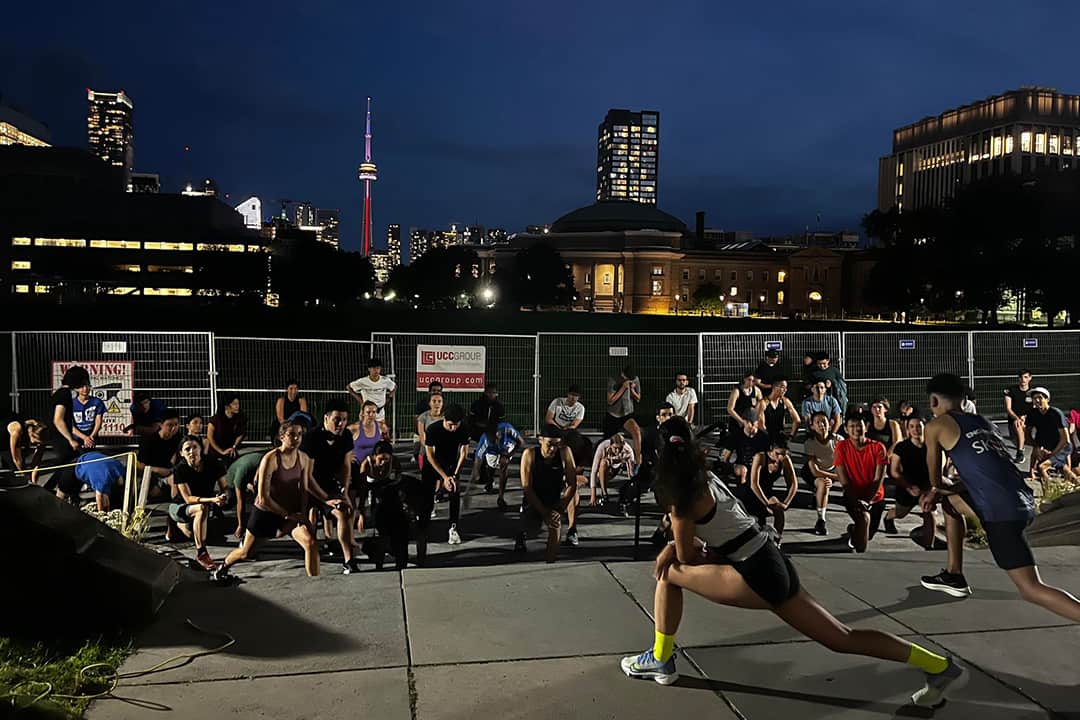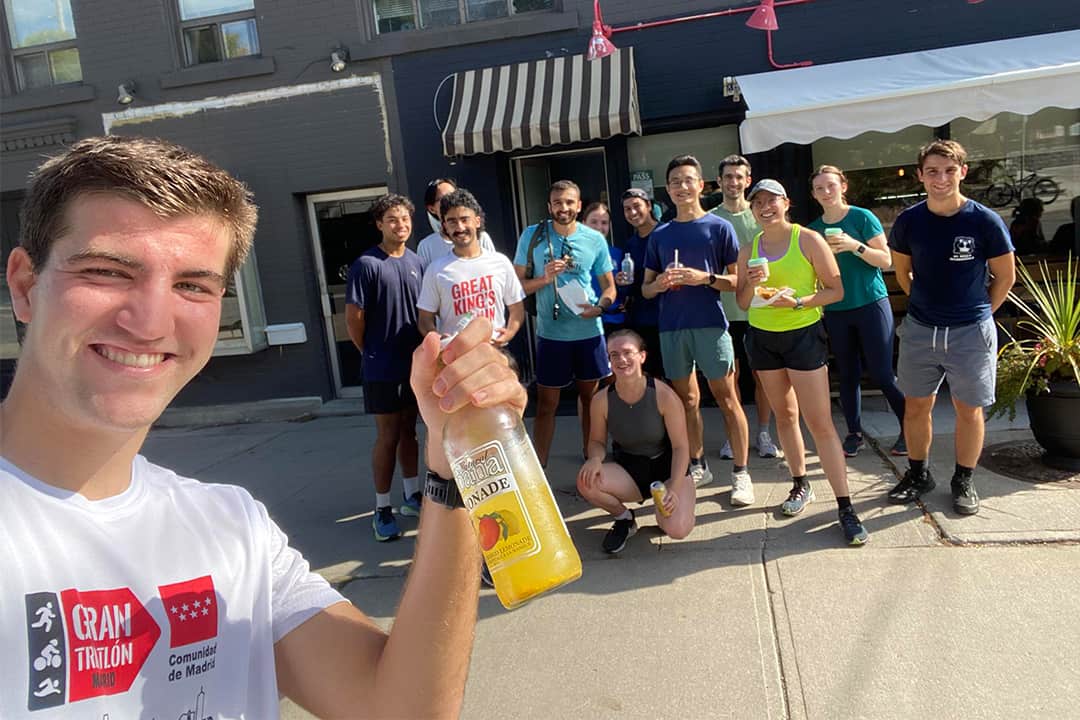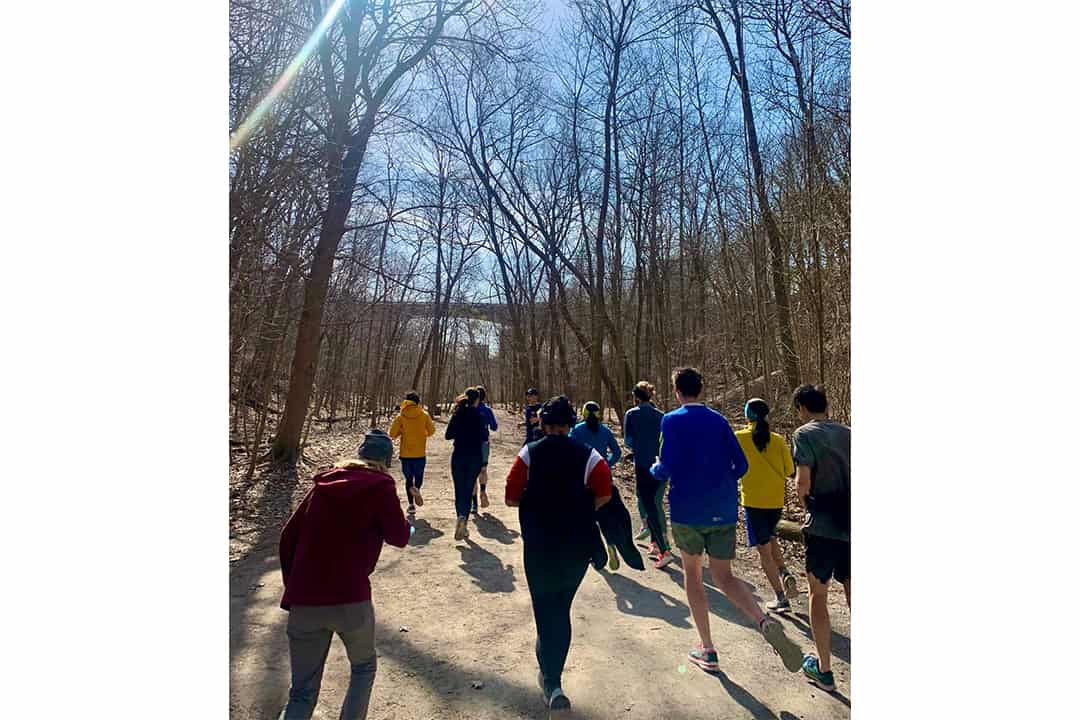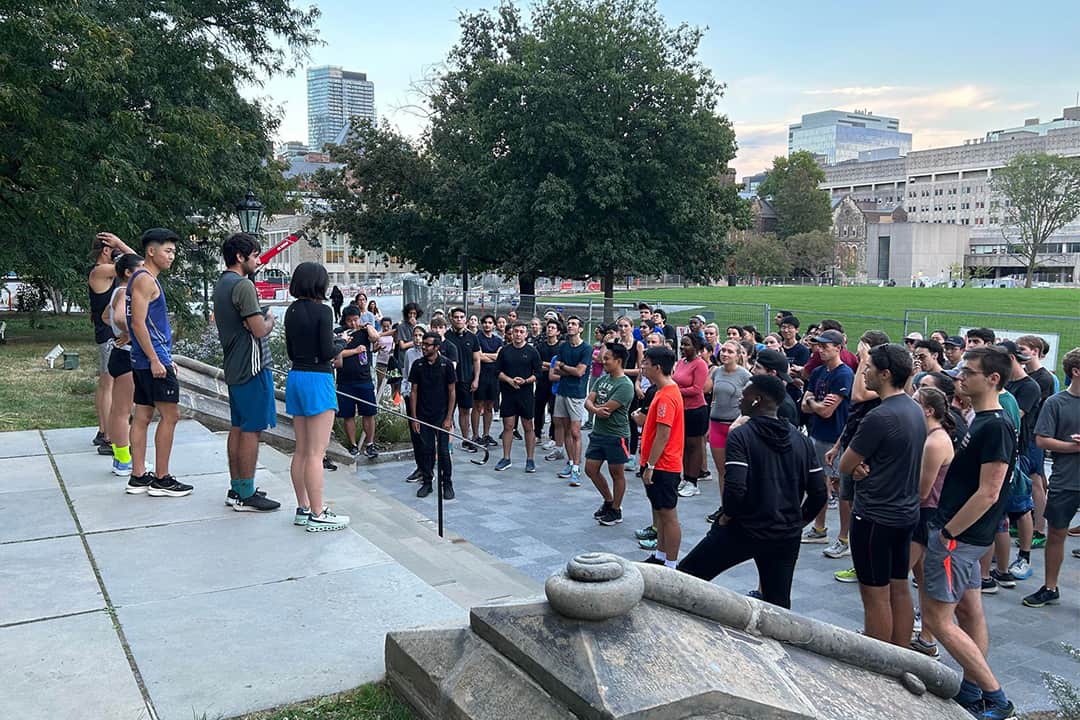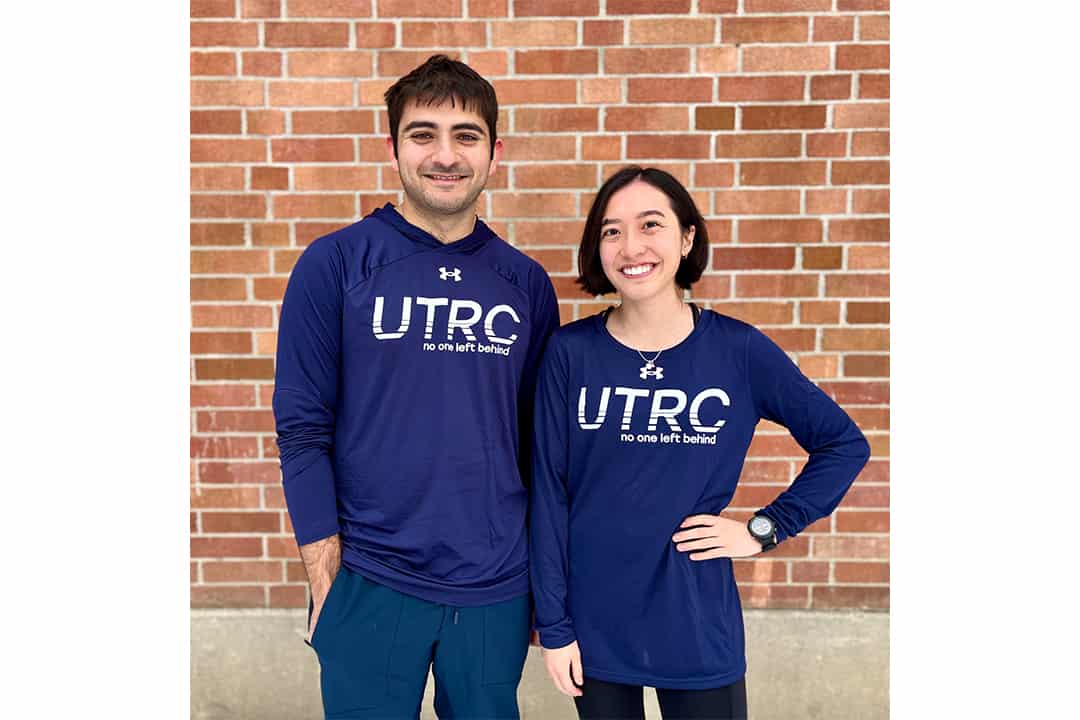It’s one foot after another, and the Toronto suburbs pass by me. There’s the brick house, the ultramodern house, and the worn-down house. I’m running, and I feel like I’m accelerating. With each step, I make sure to avoid the cracks in the pavement, and my foot only hits the ground briefly, never lingering. My hands are cold, but I feel warm. I’m paying attention to the pigeons, the thrift store about to close, and the plastic cup crushed on the sidewalk.
After I built up a baseline level of fitness, the groove of each training run has always been more or less the same. In the first few minutes, my body adjusts to this new, unfamiliar state of extra work and motion. After the first two kilometres or so, my body settles in. I hit a comfortable pace that’s sort of challenging, and I take it step by step.
I started running in June 2023 for typical reasons: it was a way to keep healthy, to feel the positive effects of endorphins, and to socialize with people. As I continued running, I progressed to 10- to 20-minute runs, and I realized that I was also running for the sense of freedom that came with covering more distance on foot, to see new neighbourhoods, and to feel the breeze on my face. Running, for me, is one avenue to set and reach self-directed goals, to regularly demonstrate self-compassion, and to root myself in my community.
What running entails
Thomas Hurka, a U of T professor emeritus of philosophy, explains that running is primarily a physical and psychological challenge rather than a mental or intellectual one. Running mostly depends upon whether one’s body can meet the physical demands of reaching a certain speed, efficiency, or distance. To do so, especially during long-distance runs, Hurka explains that there’s a “serious pain barrier that you have to get through” to finish.
Generally, all sports and games balance a couple of different goals: there are mostly physical sports like running, while others lie on the opposite end of the spectrum, like chess or bridge, which are “purely intellectual with a very little physical component.” Many sports combine intellectual and physical components. For example, top hockey players need to be physically able to skate at a certain speed, while also being able to anticipate plays and make strategic decisions.
Even though running is primarily physical and psychological, different forms of running can be more or less intellectually engaging, involving a combination of strategy and physical coordination. Trail running involves running on outdoor paths in nature, where runners must pay attention and adjust their stride to the uneven terrain as they adjust their pace accordingly. For ultramarathons, which are longer than the traditional 26-mile marathon, runners must strategize how to effectively conserve their energy, such as by walking for some sections or varying their pace to account for unexpected conditions.
Sports challenge competitors: From hurdles to goals
Beyond the health benefits or positive feelings that can come from playing sports, part of the value of sports is the challenge it provides. Hurka references a book called “The Grasshopper: Games, Life and Utopia” by Bernard Suits. The book argues that in sports and games played without any stakes, the end goal or outcome is “entirely trivial,” and the game’s interest is entirely in the challenge itself because without demanding strategy and intellect, competitive goals are “totally pointless.” Sports revolve around navigating set limitations that make one less efficient in reaching those goals. Regardless of its relative simplicity compared to other sports, long-distance running is no exception.
The goal of some sports, Hurka narrates, is to “[try] to make the ball go into a hole in the ground… [try] to stand on top of a mountain… [try] to cross a line on a track before anybody else does.” However, Suits points out that rules prevent athletes from reaching those objectives in certain ways. In Hurka’s words: “In golf, you can’t pick the ball up, walk down the fairway, and drop it in the hole by hand… In mountain climbing, you can’t take a helicopter to the top of the mountain. And in a race, you can’t say, ‘I’m going to start five minutes before anybody else.’”
It’s not that we care about the ball being in the hole or at the end point of a race for its own sake. Those outcomes matter little outside of the sport. Learning how to overcome challenges as they arise, even more so than winning every race we enter or game we play, is invaluable and intrinsic to the athletic experience.
One athlete who demonstrates this ethos is Claire Heslop, an ultramarathoner, emergency medicine physician, and a U of T assistant professor of medicine. She has entered races worldwide, from the Canary Islands to Québec to Thailand, often covering distances exceeding 100 miles.
During medical school, she began running for health purposes and convenience, as it fit with her schedule to squeeze in exercise by running back home from a shift. Although she is now a seasoned runner, initially, she also had to overcome a steep learning curve to build up her endurance — she initially considered a five-kilometre run to be long.
To Heslop, sharing the experience of long-distance running can be a transformative experience. She captures the value of facing challenges to me: “Long-distance events are a way to move the needle magically on how much you imagine you’re capable of,” she said. “And I think that brings a lot to people’s lives… [to] cross the finish line of their longest race or pull themselves out of a bad race… or push through difficulty.”
Self-compassion and confidence
For Heslop, an important part of running is taking care of yourself and your body — accepting your realities while giving yourself the mental and physical tools to tackle obstacles. At first glance, long-distance running seems like an intense sacrifice to meet a potentially outrageous distance goal. When you train to run long distances, you risk losing muscle mass through muscle catabolism because you often push your body to its absolute limits. As runners, do we actually emerge from each training session stronger and more capable than we were before? Does the pain we endure while we train have a net positive effect on our bodies and minds?
Ultimately, running fulfills Heslop emotionally and helps her feel stronger. She balances running with her other priorities, such as work and family. She acknowledges that everyone only has “one stress bucket” that can overflow. During particularly demanding weeks with multiple night shifts, she has to “dial [her training] down a little bit… and pay more attention to sleep.”
Regularly running can encourage positive self-talk, which gets reinforced during each run. To push past discomfort during long runs or a lack of motivation, Heslop reframes the situation by telling herself, “I’m fine” or by repeating small, affirming phrases, such as “You get to do this.” Moreover, numerous studies on the subject have shown that talking to yourself in the second or third person can make you feel calmer,more confident, and better able to perform tasks.
The self-compassion that runners practice also helps them distinguish what is within and beyond their control. Heslop explains that, during ultramarathons, her final time depends on many factors her training cannot prepare her for — the weather conditions, other competitors, and her level of fatigue can all change between races. Particularly, as running distances increase, there is more room for uncertainty.
During a race in February 2023, in a crowded section at night, Heslop tripped over another runner’s poles and skinned both her knees, yet pushed onward. As the night progressed, she regrouped mentally by setting a more conservative time goal. To continue racing, she would have to be more cautious to avoid another fall, and she had to let go of her time goal.
Life can come at you fast, and race expectations can change instantly. Heslop mentioned the story of another Canadian ultramarathoner she’d raced with, who was hit by a deer that had been startled by the sheer amount of runners within the first five kilometres of a race.
Heslop embraces the fact that external factors can impact her performance on race day and uses that to focus on goals unrelated to her final time. “I have more capacity for joy in the race because I’m not about to jump on myself for doing something wrong. I’m not looking to criticize or be worried,” said Heslop.
That level-headedness and sense of practicality carry over into Heslop’s work as an emergency room doctor. There could be 30 patients waiting, and there could be 50 more patients even after working as hard as possible for hours at a time. And the number of patients needing urgent care is entirely out of Heslop’s control and through no fault of her own. So, it does not help to push herself beyond a sustainable pace and she avoids blaming herself for circumstances that are beyond her control.
“The more difficulty life throws at you, [the more things will] be going outside your control… So, having a lot of compassion for ourselves really lifts the stress reaction,” said Heslop. That applies whether you’re completing a 10-kilometre run, confronting societal injustices, or coping with personal hardships.
To run long distances, you also need gusto. You need to let self-belief fuel action. Heslop describes self-belief as believing that one can surpass what they believe they are capable of and “finding out how to do that.” With appropriate training, she says, we can “find out what happens” and demonstrate one’s potential. After all, self-belief is free — and, she points out: “if you’re wrong, it’s not the end of the world.”
Community connections: The U of T Running Club
Each person’s running journey is personal — your mile time is yours alone, and you cross the finish line without anyone else’s help. But that does not mean that running is a solo sport. Here at the university, the U of T Run Club organizes two weekly five-kilometre runs on Monday and Wednesday that start at the front steps of University College.
Outside of their weekly runs, they also host 10-kilometre weekend runs and fun-themed runs. Past events have included coffee, trash cleanup runs, and fundraising — for example, a fundraiser for The Hospital for Sick Children. Participants donned special bibs and received a sticker for each lap completed around Queen’s Park. Around 40 participants ran over 600 laps that day, indicating the community’s interest and active engagement in these positive activities.
Emily Nguyen, co-president of the U of T run club and medical student, recalls an instance with the run club that helped her run consistently. During her first run with the U of T Run Club, another participant intentionally stayed back to walk with her when she struggled to complete the run. Had the other runner not demonstrated such kindness, Nguyen might have felt too “nervous or embarrassed to even come back,” she said, because of how she had lagged behind. Receiving assurance from another runner helped her feel more confident in her efforts and encouraged her to come back.
That nonjudgmental and welcoming attitude is one of the core tenets of the run club. The club’s motto is “no one left behind,” and the club leaders uphold this with each run. Given that their events sometimes have over 100 participants, they are conscious that many members are beginners and may need more support to complete runs.
By hosting runs consistently and creating an inclusive space, the club fosters many friendships and sparks connections, especially among first-year students. Ashim Bhattacharya, co-president of the U of T Run Club and pharmacology masters student, explained that “running is probably — I would say — the best way to meet people… there’s no other activity where you can so freely talk and [have a conversation with another person] while simultaneously participating in the activity.”
As a leader, Bhattacharya highlights that sparking connections and building relationships have been some of the most meaningful aspects of organizing the run club. Nguyen sums up her experience of the run club in two words: community and challenge.
Not only does running with a social club forge valuable introductions and bonds, but it also provides emotional support as people strive toward a common goal. Having led hundreds of runs in the past few years, Nguyen said, “We’ve had some people join Run Club to lose weight, and to see them, you know, achieve that goal [is rewarding]. We’ve had some people join Run Club to become fitter. You know, they can barely run [five-kilometres] the first time, and now they’re running half marathons.” People build a sense of camaraderie through the joys and challenges of running regularly with people with similar ambitions.
Running with other people who show up for similar purposes can help people feel more rooted in their community. Runners see familiar faces and spark meaningful conversations with each other. Through that simple process, runners gradually feel more integrated into a community or place and learn to feel that their presence matters to those around them, regardless of how well they know them.
Keeping on
Heslop’s words still ring true: we can only control what we can physically control, and despite our efforts, the outcomes of our goals often depend on factors beyond ourselves. It’s a bit of a truism, but hearing it from an elite runner reframes for me what it means to set an ambitious goal and show resilience. That perspective has worked for her. Maybe we, too, can learn to embrace that belief and redirect our energy to take pride in our small accomplishments in pursuit of big goals.
More importantly, I can put that sentiment into practice every time I lace my shoes to run. I can see how running can give me a sense of agency and shape my perspective. When I am having a bad day, feeling worried, sad, lonely, or whatever else in between, if there’s one thing I can do, it’s run. When I run in the cold and rain, I feel as if I can defy the weather by resisting the common temptation to stay inside at home.
When I’m on a long run outside, my breathing becomes laboured, yet I am focused enough to reflect on my day and take in the scenery around me. I see the patterns in the sky. The clouds look wispy and soft, and I see patches of blue in the distance. Running makes me wonder if there is something more to life, a purpose to my life, and if I will touch it. In the larger scheme of things, I feel small and insignificant. But those are questions I will never receive definitive answers to. As I run harder, those questions fade away. I am relieved. Every run simplifies the noise in life a little bit.
Maybe I would even keep running if there were no physiological benefits, if there was no scenic view, or if there was no upcoming race. Maybe I would keep running just to take step after step, step after step. Maybe I would run for the sake of running alone.

